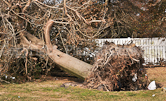 It
is amazing how much wind certain trees can withstand
while others topple over in a mere breeze. There are
several factors that account for the difference.
It
is amazing how much wind certain trees can withstand
while others topple over in a mere breeze. There are
several factors that account for the difference.
Trees slammed to the
ground during a hurricane or tornado is easy to
understand. These natural weather phenomena generally occur when
the leaves are on the deciduous trees which presents
more resistance to the power of the wind. So, often
otherwise healthy trees may go down under these
circumstances.
In lighter or no wind
conditions, it is often hard to understand why a certain
tree came down. The key is usually one or more of the
following factors:
1. Bad Root System
- Under ideal soil and growth conditions, a tree should
be able to withstand pretty violent wind gusts. They
will have a root system that is spread out far and wide.
In addition to absorbing water and nutrients, one of the key
roles of a root system is to
anchor the tree.
Most people mistakenly
think that a tree's roots spread only to the outside of
the canopy of leaves. This is wrong. The distance that
roots extend out from the trunk of a tree varies by
species. Some species send roots out in all direction up
to 1.5 times the height of the tree. This means that a
100 foot tall tree could be sending roots out 150 feet
in all directions (under ideal conditions, of
course). Other trees such as
spruces extend out only 2/3 the height so a 30 foot
tall tree sends roots out about 20 feet around.
As mentioned above, these
extensive root systems are present under "ideal"
conditions. Less than ideal factors which will limit the
root system of the tree would include:
A. Compacted Soils
- Roots of plants need oxygen to expand and grow.
Compacted, usually high
clay,
soils squeeze out all the air. Therefore, the roots
grow nearer the soil surface and struggle to expand
and grow properly.
B. Poor Drainage
- If the spaces in the soil are all filled with
water too much of the time, the roots are denied the
oxygen they need to expand and thrive. Also, the
presence of so much water will often lead to
root rot
diseases.
C. Physical
Restrictions - We build houses, sidewalks,
driveways and other obstacles which physically
prevent the expansion of tree roots into their
normal range and size.
D. Damage to the
Roots - Construction of structures, sewers, irrigation
systems, etc. will cut and damage root systems.
2. Tree Rot -
Internal rot in the trunk or major branches cause more
susceptibility to wind damage. Often, this type of
damage can not be easily detected from the outside. More on
tree rot.



